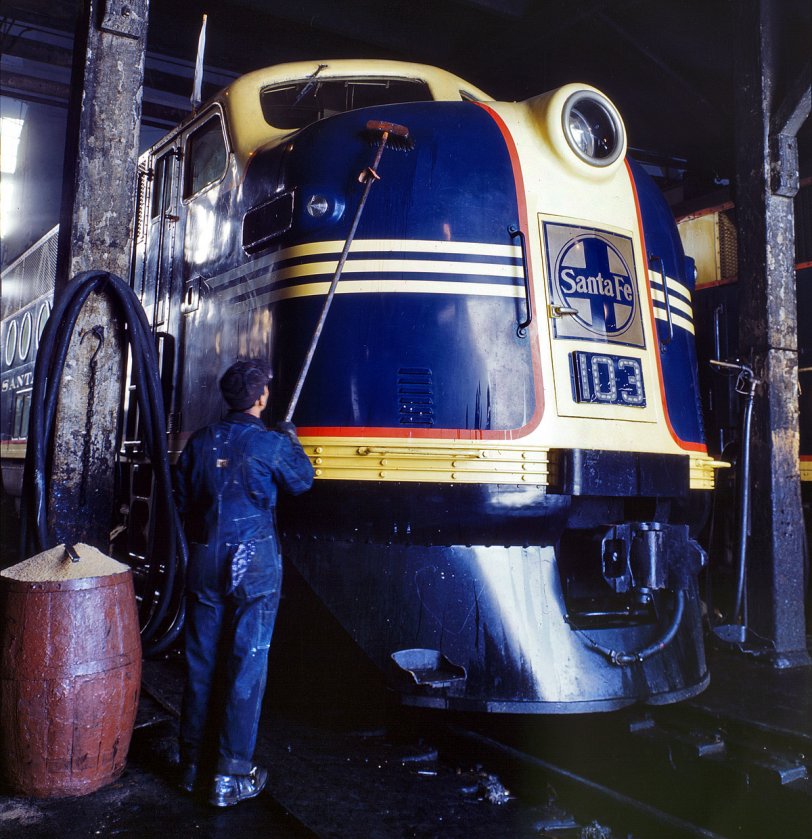


Framed or unframed, desk size to sofa size, printed by us in Arizona and Alabama since 2007. Explore now.
Shorpy is funded by you. Patreon contributors get an ad-free experience.
Learn more.

- Baldwin 62303
- Baldwin VO-1000
- Cold
- No expense spared
- Tough Guys
- Lost in Toyland
- And without gloves
- If I were a blindfolded time traveler
- Smoke Consumer Also Cooks
- Oh that stove!
- Possibly still there?
- What?!?
- $100 Reward
- Freeze Frame
- Texas Flyer wanted
- Just a Year Too Soon
- WWII -- Replacing men with women at the railroad crossing.
- Yes, Icing
- You kids drive me nuts!
- NOT An Easy Job
- I wonder
- Just add window boxes
- Icing Platform?
- Indiana Harbor Belt abides
- Freezing haze
- Corrections (for those who care)
- C&NW at Nelson
- Fallen Flags
- A dangerous job made worse
- Water Stop
Print Emporium
Santa Fe Diesel: 1943

March 1943. Washing one of the Santa Fe R.R. 5,400-horsepower diesel freight locomotives in the roundhouse at Argentine, Kansas. View full size. 4x5 Kodachrome transparency by Jack Delano.
Aboard the Super Chief
Throne first
My grandfather rode in these things. The crew restroom is located directly behind the Santa Fe logo on the nose. It is an odd and vulnerable feeling to be sitting in there while hurtling along at high speed, knowing you'll be the very first thing to be crushed if this zillon-ton monster runs into anything!
Santa Fe
I grew up in a 3rd generation Santa Fe house in Oklahoma. I used to get to ride form North of Tulsa to Cherryvale, Kansas to see my Grandmother. It was always a treat to ride the train.
Body and Paint changes
I've ordered the FT set A,B,B,A and wondered how much work it would be to show them as F7's. Thanx for a great web site.
SF #103
#103 shown here was part of the first four sets of FT engines that ATSF purchased from EMD (General Motors) in January 1941. Units #100-104 each consisted of a cab lead engine, two cabless boosters and a trailing cab unit (an "LABC" configuration). A total of 320 FT units were acquired by August 1945. These were used primarily in CA and AZ resulting in total dieselization of "through" freight trains (Winslow, San Bernardino, Bakersfield) when this great photo was taken.
After the war, the #103 set was moved to the Argentine-Corwith freight pool on the Illinois-Missouri division of the ATSF (KC-Chicago). #103 lasted until 1960-61 when it was traded back to EMD for a new road switcher.
The early nose paint scheme shown here only existed on the #100-104 units. The red striping and SF shield were replaced by the classis yellow "cigar-band" used on all later blue FT/F3/F7 and ATSF passenger engines.
Engine Colour
It wasn't unusual for railroads to have different paint schemes for their freight and passenger diesels with the passenger engines getting the flashier or more elegant colours. On the Pennsylvania Railroad most passenger engines were a sort of maroonish red known as Tuscan Red, while the freight engines were an extremely dark green. It's not surprising really - the passenger equipment was the face that the railroad showed the world and it had to be clean and elegant and modern because some of the people who rode in those passenger trains would make decisions on what line they'd use in their freight business. That at least was the philosophy in the 1940s.
What you see on this picture that you don't see anymore is the detail of the paintwork even on this workhorse engine. There are at least three colours here, four if you count what is probably brushed stainless steel or aluminum on the Santa Fe logo on the nose of the engine. There's the red striping separating the main yellow area from the blue, and the three stripe yellow "wings". It is, for lack of a better term, fancy. These days locomotives are frequently one or two colours (often red or black, sometimes blue) and the way engines are painted is very utilitarian. It saves money at the paint shop (and mechanised cleaning saves money too even if it often isn't very effective) but it sends an equally untilitarian message to the public.
Horse of a different color!
Santa Fe really had a lot of horses of a different color!
For those of us who KNEW that the only AT&SF color scheme was silver/red, that is a real letdown.
And, yes, those Kodachrome transparencies are doozies! Somebody should write a song about them.
The Art Of Industrial Design
It's just an old train but this photo definitely makes it a work of art.
"I got them steadily depressin', low-down mind messin', working at the train wash blues." (apologies to Jim Croce)
And you thought you had a lousy job working at the carwash.
The first AT&SF FT's
The first AT&SF FT's delivered in A-B-B-B configuration, as the Brotherhood of Locomotive Engineers didn't like the idea of there being two cabs and only one engine crew. Later contract negotiations allowed for uncrewed A units to be multiple united.
not only rail fans
I don't give a hoot about trains per se, but I find all Delano's photos of them completely engrossing. The color, the composition...... Amazing photographer. Thanks for another one.
Santa Fe Diesel
You can say that again!! The Loco in the picture would be the 1st mainline diesel freight unit built by EMD, the FT-103 A-B-B-A unit to replace steam. Each individual unit was rated a 1,350 HP for a total of 5,400 HP for all four coupled up. A = cab unit, B = booster unit.
Great for railfans!
What a great photo for railfans!
























On Shorpy:
Today’s Top 5